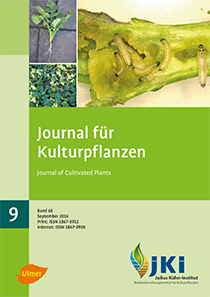Passive extraction of Cabbage stem flea beetle larvae (Psylliodes chrysocephala L.)
Keywords:
Psylliodes chrysocephala, passive extraction, larvae, Funnel-MethodAbstract
An easy but not widely used method to determine the number of Psylliodes chrysocephala larvae in winter oilseed rape plants was studied. The Funnel-Method can be considered as a modified Berlese-Funnel-Method with no heat supply. The passive extraction of cabbage stem flea larvae generated nearly the same results as the manual dissection. The big advantage of using such a Funnel-Method is that distinctly less labour time is needed; the disadvantage is that the extraction needs up to 21 days until all larvae have left the plant tissue and that the larval stages cannot be determined anymore for a specific plant collection date. The results of this study indicate that the Funnel-Method is a cheap and simple tool for practical use but with a time delay before results are available.
DOI: 10.5073/JfK.2016.09.01, https://doi.org/10.5073/JfK.2016.09.01








